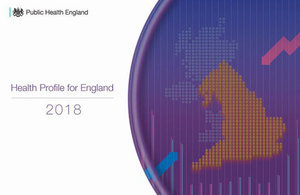Current and future state of nation’s health revealed
PHE has published a new Health Profile for England report giving the most comprehensive picture of the health of England today and into the future.

The Health Profile for England report covers life expectancy; major causes of death; mortality trends; child health; inequality in health; wider determinants of health; and current health protection issues. Data and evidence contained in Health Profile for England will be used to help shape the forthcoming NHS long term plan.
As a society, people are living longer – life expectancy in England has reached 79.6 years for men and 83.2 for women and we’re healthier at every age group than ever before. However, stubborn inequalities persist – in the richest areas people enjoy 19 more years in good health than those in the poorest areas.
A major theme of the Health Profile for England report is future trends in health, which will aid policymakers to prioritise efforts to prevent ill health not just deal with the consequences.
Some of the most notable findings include:
- the number of people aged 85 years has more than tripled since the 1970s and will include more than 2 million people by 2031
- the death rate for dementia and Alzheimer’s disease – already the leading cause of death in women – may overtake heart disease in men as early as 2020 and is likely to become the leading cause of death in men too
- the number of people with diabetes is expected to increase by a million – from just under 4 million people in 2017 to almost 5 million in 2035
- in the last 7 years, smoking prevalence has dropped by a quarter to 15% and as little as 10% of the population could still be smoking by 2023
The report also provides details on the nation’s current health position:
-
UK women’s health is faring worse than their European counterparts, ranked 18th lowest out of 28 EU member states for premature death. UK men are doing better by comparison and are ranked 10th.
-
Low back and neck pain and skin disease (dermatitis, acne and psoriasis) are the 2 leading causes of morbidity for men and women, with hearing and sight loss also ranking highly for both sexes
-
While most causes of morbidity become more prevalent with age, mental health problems and substance use affect younger adults the most, accounting for more than a third of the disease burden in those aged 15 to 29 years.
Duncan Selbie, chief executive at Public Health England, said:
Inequalities in health undermine not only the health of the people but also our economy.
As we work to develop the NHS long term plan, we must set the ambition high. If done right, with prevention as its centrepiece, the payoff of a healthier society and more sustainable NHS will be huge.
Professor John Newton, director of health improvement at Public Health England, said:
Now in its 70th year, demands on the NHS have changed significantly.
More of us are living longer with painful or disabling conditions, including musculoskeletal problems, skin conditions and sensory loss. While these illnesses often attract less attention than causes of early death such as heart disease and cancer, they have a profound effect on the day to day lives of many people and together they place significant pressure on the NHS.
The challenge now is for the NHS to respond to this changing landscape and to focus on preventing as well as treating the conditions which are causing the greatest disease burden across our nation.
The new report also shows that good public health is not defined by health policy alone – a high-quality education, a well-designed and warm home, a good job and a community to belong to are just as important.
Health Profile for England has been created with policymakers, both national and local, in mind. PHE wants them to use the report as a shared reference point and to think about the broader impact of their policies on health. The report also links to further PHE tools to allow local policymakers to see how their area compares with the national picture.
Background
The Health Profile for England report’s 7 chapters are:
-
Population change and life expectancy
-
Trends in mortality
-
Trends in morbidity and risk factors
-
Health of children in the early years
-
Inequality in health
-
Wider determinants of health
-
Current and emerging health protection issues
PHE is leading the prevention, personal responsibility and health inequalities work stream as part of the development of the NHS 10 year plan.